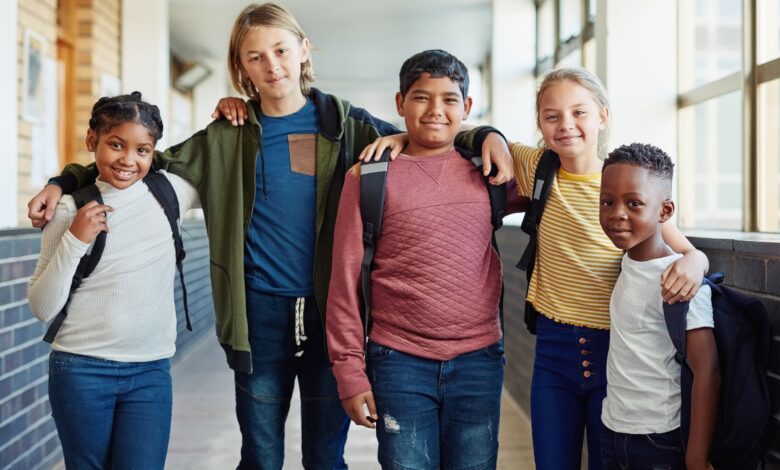
Schools should be places where students grow and learn safely. But sadly, school violence has become a big problem. What if we could find a way to stop this? Social-emotional learning (SEL) might be the answer. It’s a new way to help students feel better and make schools safer for everyone.
Have you ever seen some students handle school life better than others? SEL might be the reason. It teaches students to be more empathetic, solve conflicts, and understand themselves better. These skills help them make good choices and get along with others. This can really help stop school violence.
Key Takeaways
- Social-emotional learning (SEL) is a powerful tool for addressing the root causes of school violence.
- SEL helps students develop crucial skills like empathy, conflict resolution, and self-awareness.
- Implementing effective SEL programs can foster a positive school climate and prevent youth violence.
- Trauma-informed practices and a focus on student well-being are essential in creating safe, supportive learning environments.
- Combining SEL with comprehensive school safety measures can create a holistic approach to addressing school violence.
Understanding the Gravity of School Violence
School violence is a big worry that affects many people. It causes harm that goes beyond just physical injuries. Students, staff, and families often face long-term emotional and psychological damage.
Alarming Statistics and Consequences
Recent data shows that school violence is getting worse. Incidents like bullying, fights, and active shooter situations are happening more often. The National Center for Education Statistics says 20% of students aged 12-18 were bullied in the 2019-2020 school year.
Also, the Centers for Disease Control and Prevention found that 6% of high school students got threatened or hurt with a weapon at school.
The effects of school violence are huge. Students who go through or see violence at school often face mental health problems. This includes anxiety, depression, and post-traumatic stress disorder. They might do worse in school, miss more classes, and face emotional and social issues later on.
This violence also affects the whole student safety and community. It makes people feel less safe and less trusting, hurting everyone’s well-being.
| Statistic | Percentage |
|---|---|
| Students aged 12-18 who experienced bullying | 20% |
| High school students threatened or injured with a weapon on school property | 6% |
The scary stats and big effects of school violence show we need strong trauma-informed practices and good solutions. This is a big problem that needs a wide-ranging approach to keep our students safe and well.
“The impact of school violence can be devastating, with lasting consequences for the entire community. It’s a complex issue that requires a multifaceted approach to ensure the safety and well-being of our students.”
The Role of Social-Emotional Learning
In the fight against school violence, social-emotional learning (SEL) is key. SEL teaches students important skills like empathy, conflict resolution, and emotional regulation. These skills help prevent and handle violence.
SEL makes schools positive places. It helps students feel safe, valued, and able to solve problems without violence. When students know how to handle their feelings, they can deal with tough situations better.
SEL also helps students care about others. By understanding others’ feelings and views, students are more likely to solve problems with words, not fights. This makes school safer for everyone.
- SEL teaches important skills like conflict resolution and emotional regulation. These skills are key in stopping and dealing with school violence.
- A positive school climate, made better by SEL, makes students feel safe and able to solve problems peacefully.
- SEL helps students be more empathetic. This means they can see things from others’ viewpoints, leading to better ways of solving problems.
By adding social-emotional learning to school, teachers can greatly help in student well-being. This can lead to safer, more caring schools for everyone.
School Violence, Social-Emotional Learning: Implementing Effective SEL Programs
Dealing with school violence needs a complex plan. A big part of this is using Social-Emotional Learning (SEL) programs. These programs teach students how to handle their feelings, make good friends, and create a positive school atmosphere. This helps stop and lessen violence.
Successful SEL programs use several key strategies:
- School-wide initiatives: Making SEL a big part of the school’s culture. This means making a safe, welcoming place for everyone.
- Teacher training: Giving teachers the skills and tools to teach SEL in class.
- Evidence-based practices: Using SEL programs that have been shown to work well.
Getting students involved in SEL is also key. When students help shape SEL programs, they feel more connected and invested. This makes the programs more effective for them.
| Key Strategies for Effective SEL Implementation | Benefits |
|---|---|
| School-wide initiatives | Makes the school a positive, welcoming place for everyone. |
| Teacher training | Helps teachers teach SEL well. |
| Evidence-based practices | Uses proven SEL programs. |
| Student engagement | Helps students feel a part of the SEL process. |
By using a full, team effort to put SEL programs into action, schools can help their students. They can create a place full of empathy and respect. This is a big step in fighting school violence.

“Social-emotional learning is the missing piece in the education puzzle. When we focus on developing the whole child, we unlock their full potential to thrive in school and in life.”
Cultivating a Positive School Climate
Creating a positive school climate is key to tackling school violence. It’s about making a place where empathy, respect, and solving conflicts well are valued. Social-emotional learning (SEL) is a big part of this. It gives students the skills to get along with others and handle their feelings.
Promoting Empathy, Respect, and Conflict Resolution
SEL programs focus on building empathy. This helps students see things from another person’s point of view. When they can do this, they’re less likely to act out or be violent. It’s also important to teach students to respect everyone’s differences and solve conflicts peacefully.
- Implement SEL curricula that focus on developing emotional intelligence and interpersonal skills
- Foster a culture of inclusion and acceptance, where students feel valued and supported
- Provide training for teachers and staff on conflict resolution techniques and effective classroom management strategies
- Encourage open communication and collaboration between students, teachers, and administrators
By focusing on these areas, schools can make a place where students feel safe and respected. This helps them make good choices and can prevent violence. It also makes the whole school community healthier.
“A positive school climate is not just a feel-good measure—it’s a critical component of school safety and student success.”
| Factors Contributing to a Positive School Climate | Outcomes of a Positive School Climate |
|---|---|
|
|
Conclusion
Exploring social-emotional learning in schools shows great promise in stopping school violence and helping student well-being. By teaching students important skills like emotional smarts, empathy, and solving conflicts, we make safer and supportive learning places.
We need a full plan that gets everyone in the school community involved – teachers, leaders, parents, and students. Working together and caring about school safety, we can build a place where everyone respects and understands each other. This helps our young people deal with problems in a strong and kind way.
Looking ahead, we must remember that making school violence prevention and social-emotional learning work needs the whole community’s active help. By joining forces, we can make sure every student does well in school and feels good, leading to a better, safer future.
FAQ
What is the connection between school violence and social-emotional learning (SEL)?
Social-emotional learning is key in fighting school violence. It teaches students to understand others, solve conflicts, and manage their feelings. By doing this, SEL makes schools safer and more supportive for everyone.
What are some alarming statistics and consequences of school violence?
School violence is a big problem, causing mental health issues, lower grades, and trauma. Sadly, bullying, fights, and active shooter events happen too often in schools. These incidents affect students and communities deeply.
How can SEL programs help combat school violence?
SEL programs give students skills like empathy and problem-solving. These skills help prevent and handle violence. By making schools positive places, SEL helps students feel safe and able to solve problems peacefully.
What are the key strategies for implementing effective SEL programs in schools?
To make SEL work well, schools need a full plan. This means doing things school-wide, training teachers, and using proven methods. It’s also important to get students and the community involved to make SEL a big part of school life.
How does a positive school climate contribute to addressing school violence?
A positive school feels full of empathy, respect, and good ways to solve conflicts. This is key to stopping and dealing with violence. By teaching SEL, schools can be places where everyone feels safe and valued, building a strong community.




